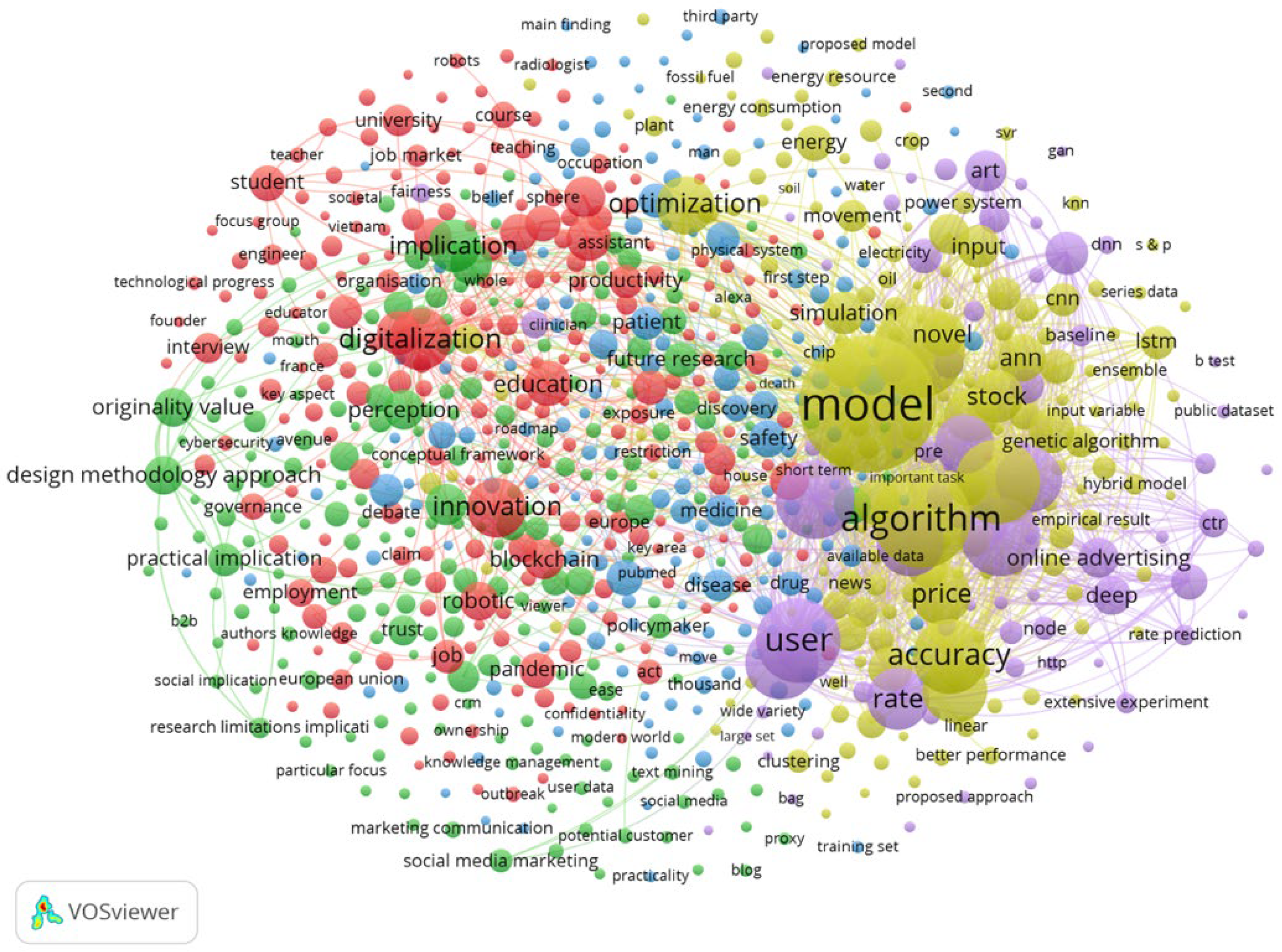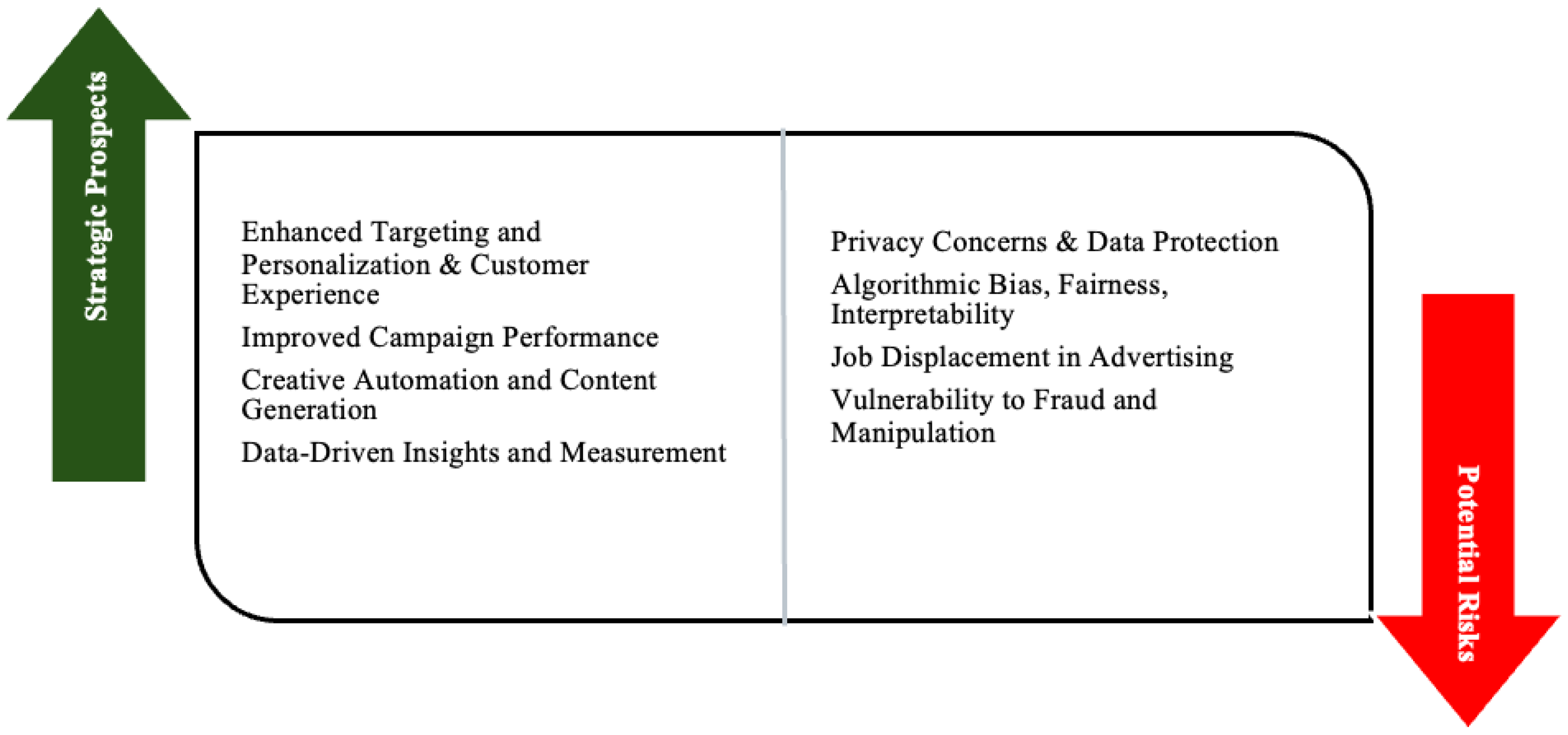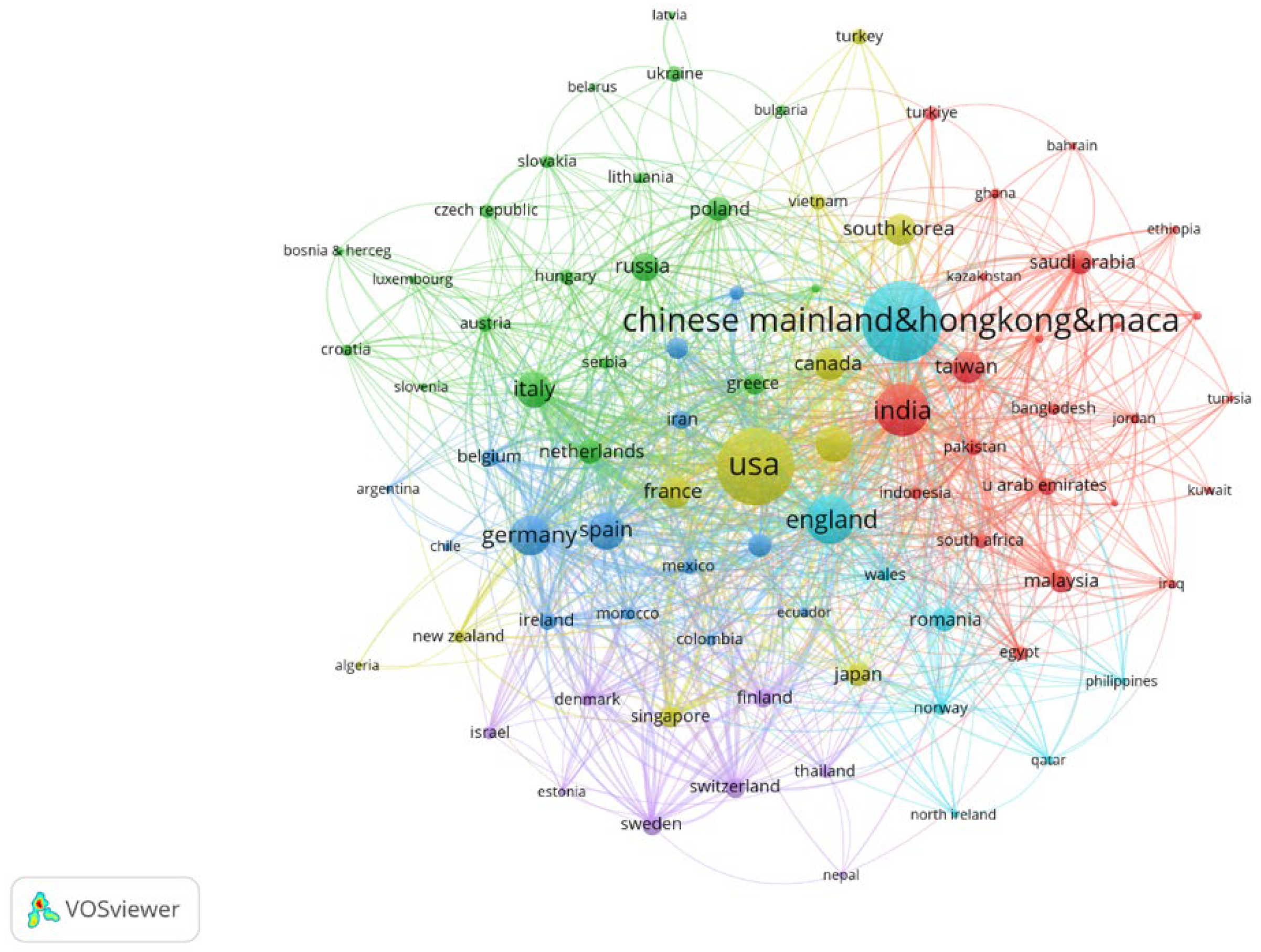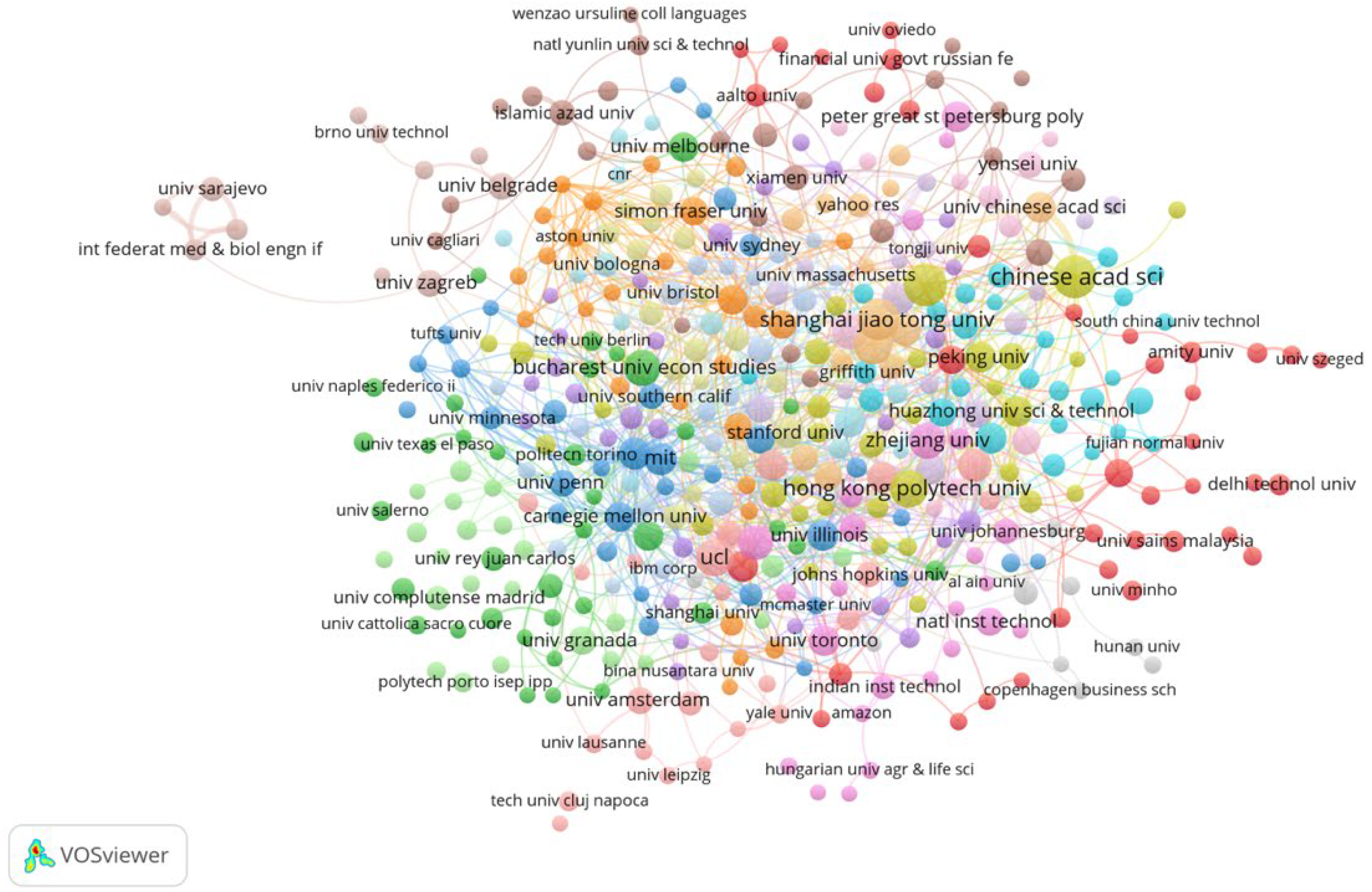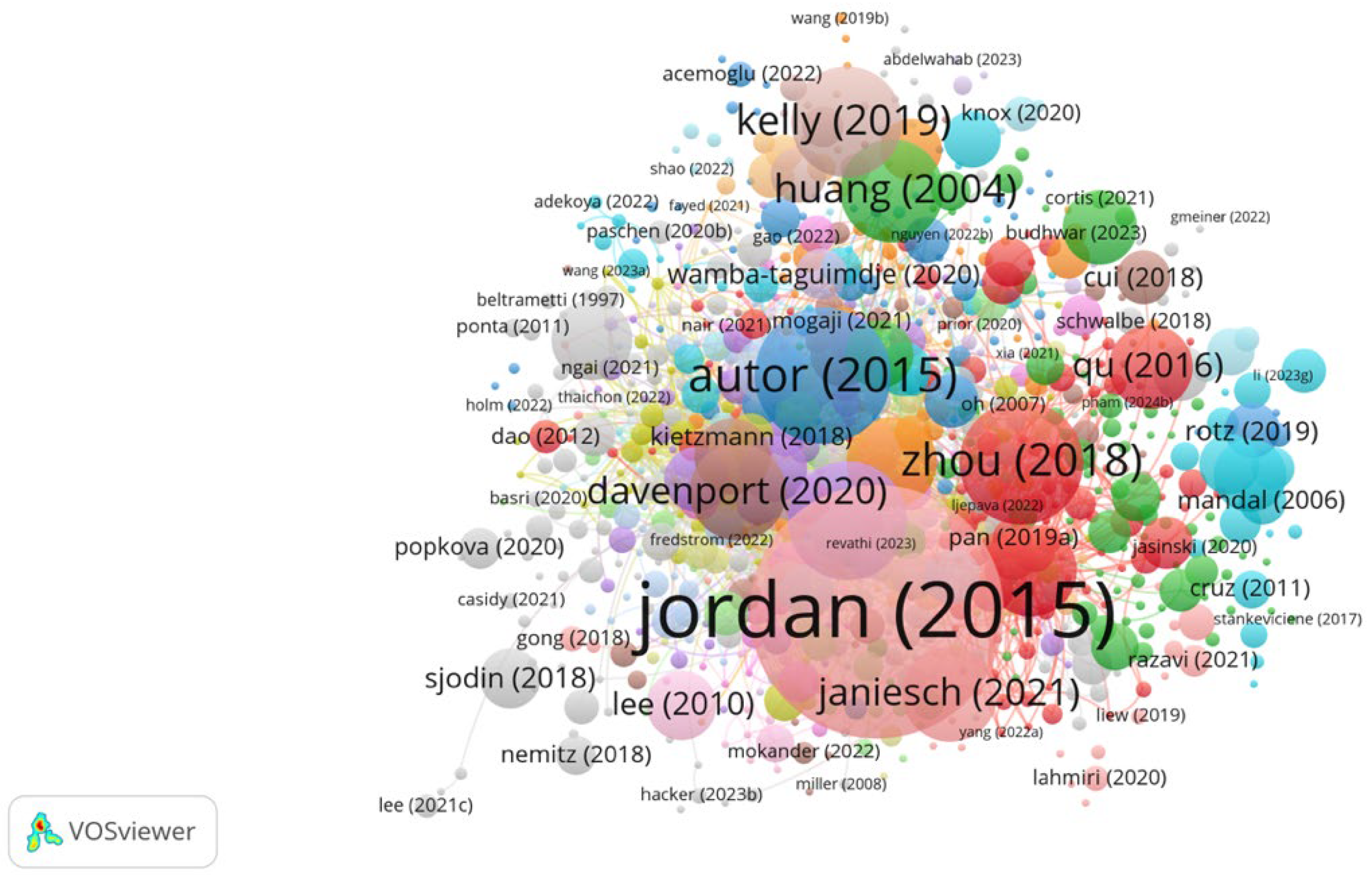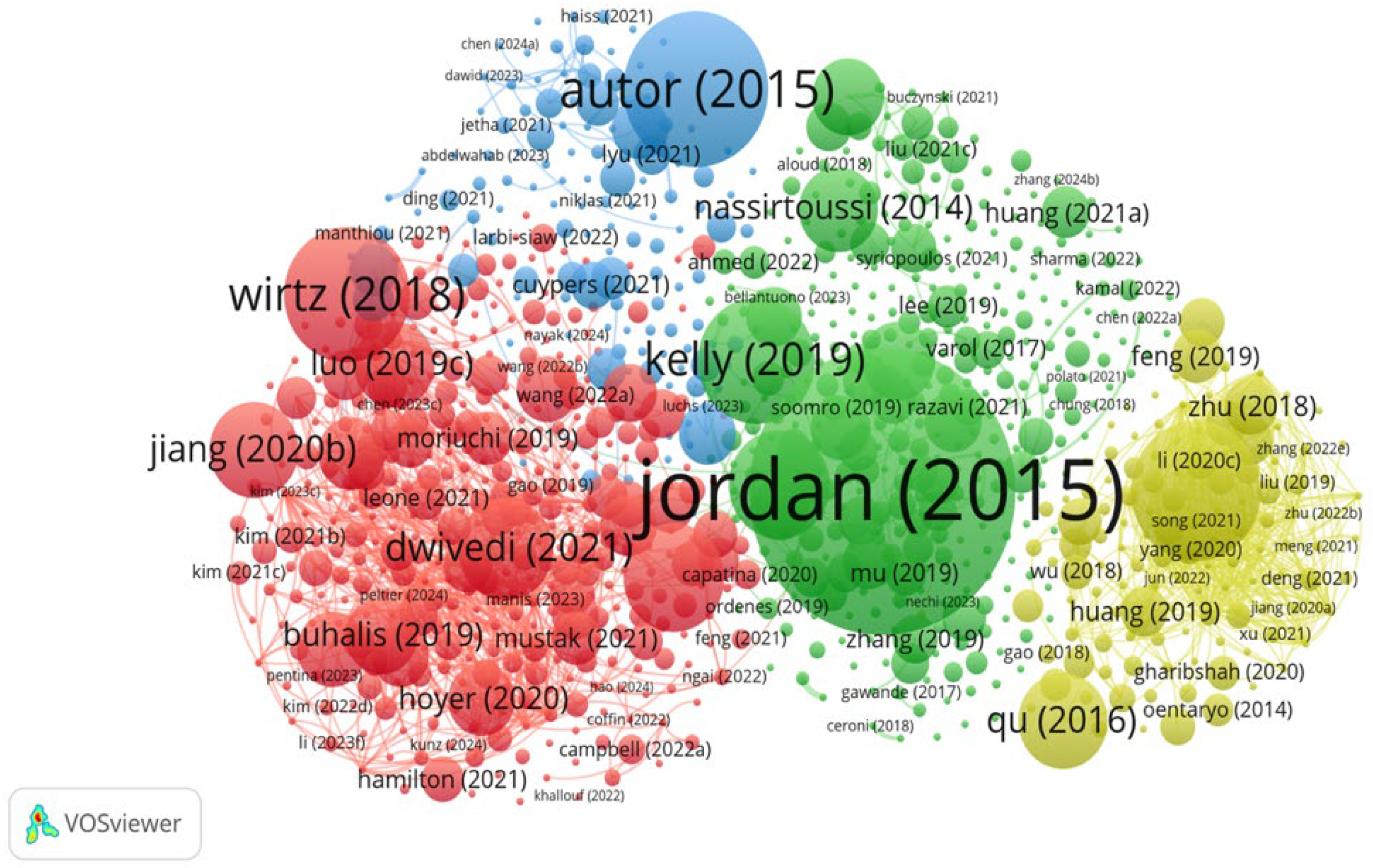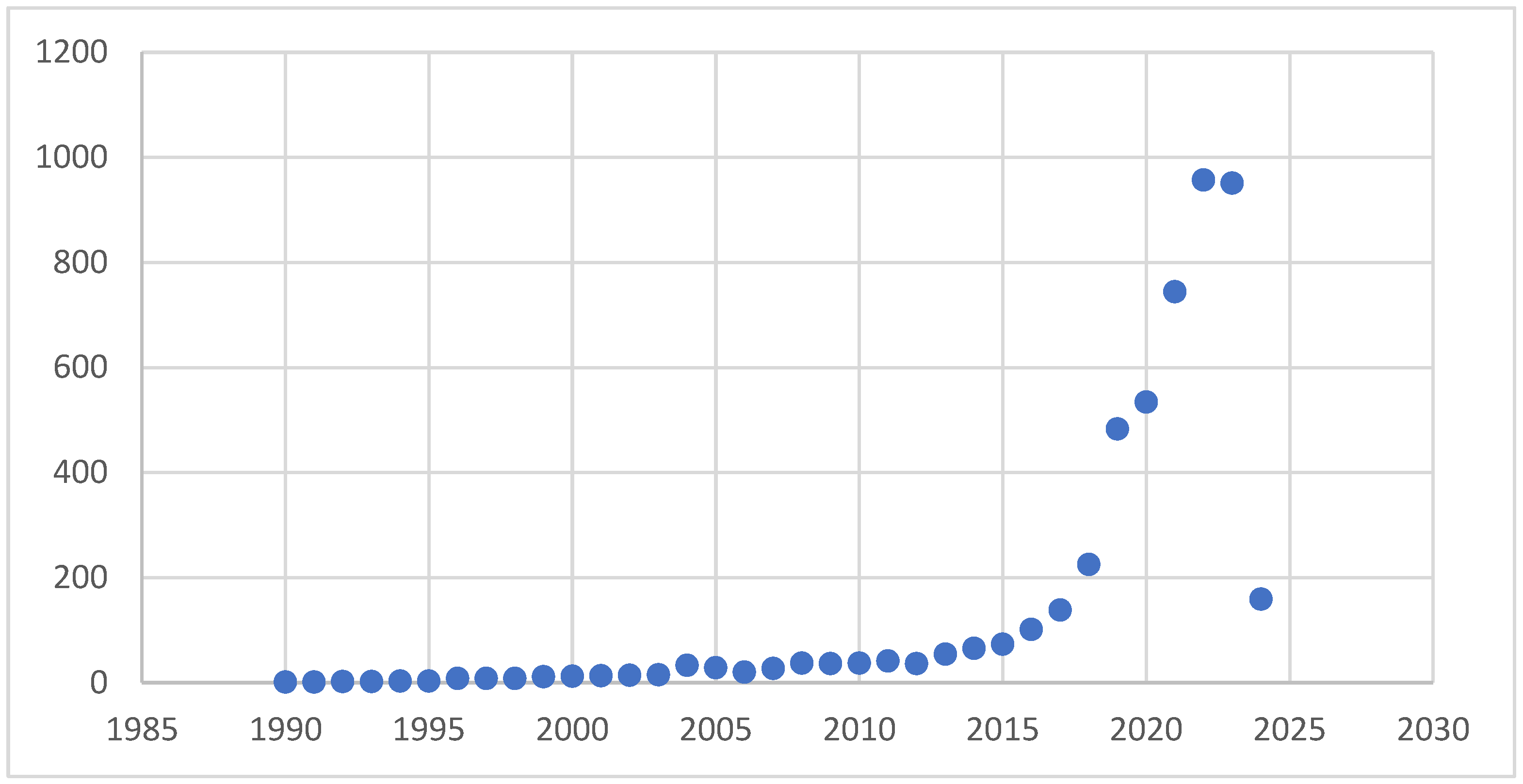3.1. Investigating Co-Occurrences of Terms
We performed keyword co-occurrence analysis to understand how research on generative AI in advertising has evolved. Keywords, such as machine learning, customer engagement, automation, and brand personalization, emerged as central nodes across multiple clusters. This trend highlights an increased scholarly focus on performance-driven application in the field.
Figure 2 visualizes 871 nodes representing co-occurring terms clustered into five groups. These terms were extracted from publications and clustered into specific themes, as shown in
Table 1. These were formed by analyzing the interconnected terms. A detailed breakdown of subtopics is shown in
Table 2. The cluster with the highest degree of centrality belongs to Clusters 4 and 5, where terms such as model (858), algorithm (805), performance (798), user (769) and prediction (734) are found. These terms underscore fundamental importance in advancing the understanding, application, and development of AI in advertising research, with models and algorithms at the forefront. Researchers use AI models and algorithms to analyze data, predict user behavior, and optimize advertising performance. This methodological significance may interest researchers in publishing papers evaluating AI-driven campaigns’ effectiveness, which makes these terms more frequent. Users reflect the user-centric approach of AI Advertising research as AI enables advertisers to better understand user behaviors and preferences better, leading to more personalized and targeted advertising experiences. “Prediction”, which refers to predictive capabilities, may indicate deployment of AI models and algorithms that can anticipate user actions and preferences, enabling advertisers to deliver timely, relevant advertisements, making it a hotspot for many researchers. Lastly, as part of the top five terms with the highest centrality, “core concepts” form the foundation for theoretical frameworks, empirical studies, and practical applications, which are likely to be the central discourse of this field.
Table 1 involved a two-stage process. First, co-occurring terms from the publications were identified and clustered using VOSviewer. VOSviewer’s analysis generated five distinct clusters of interconnected terms based on their co-occurrence frequency within the dataset. These clusters were represented by color which are automatically assigned by VOSViewer per group. Second, after the VOSviewer clustering, we performed a manual thematic analysis on the resulting clusters to determine overarching themes and concepts and to assign meaningful topic labels. These themes were then summarized and organized into the five main topics presented in
Table 1. This manual assignment ensured that the resulting issues in
Table 1 were coherent, interpretable, and accurately reflected the content of the co-occurring terms identified in the initial VOSviewer analysis. The detailed breakdown of subtopics within each main topic is presented in
Table 2.
Following topic detection from
Table 1, concepts and themes were manually analyzed and grouped into two overarching categories: strategic prospects and potential risks. This categorization adhered to the framework established by Fulton et al. (2024) [
64], which analyzes AI’s multifaceted impacts across eight categories: societal, economic, ethical, political, environmental, data, technological, and organizational. Each concept or theme from
Table 1 was classified as either a benefit (strategic prospect) or a risk, depending on its context. The resulting data were then organized into a smart chart (
Figure 3), revealing that contributors to both strategic prospects and potential risks mainly came from Clusters 2, 3, and 5, as these clusters emphasize application-focused dimensions of AI advertising, making them key drivers of both challenges and opportunities in the field. The smart chart further highlights AI’s central role as a technology driving advancements in AI advertising.
AI enables strategic targeting and personalization, real-time bid placement and targeting optimization, creative automation, and content development in advertising. AI-driven advertising boosts customer engagement and conversion rates, while real-time optimization of budget allocation and ROI. AI improves marketing success, user behavior, and decision-making, while chatbots improve customer satisfaction and assistance. This quickens the process and reduces costs. In the aspect of AI in advertising, designing compelling campaigns is possible with collected data.
This shift indicates that the advertising knowledge ecosystem is rapidly adapting to the operational logic of AI technologies, emphasizing efficiency, segmentation, and personalization. However, as demonstrated in broader studies of knowledge–society interfaces, effective technological adoption also depends on fostering transparent, inclusive engagement between expert communities and the wider public to ensure societal trust and accountability [
65]. The relative absence of terms related to governance, regulation, or long-term societal impacts signals a potential blind spot. While researchers are eager to examine the benefits of AI, the strategic risks, such as algorithmic bias or ethical constraints, remain underdeveloped as thematic clusters.
These opportunities also entail risks, as vast volumes of user data will create privacy concerns, requiring strong data protection mechanisms. Furthermore, AI may reinforce biases, leading to unfair targeting and discrimination. Some AI models lack transparency, reducing online advertising transparency and accountability, compromising accuracy. AI systems are vulnerable to fraud and manipulation, making them exploitable. Finally, AI advertising automation raises concerns about job loss and extinction.
3.2. Investigating Knowledge Sources Through Co-Authorship Analysis (Countries and Institutions)
Worldwide scientific collaboration involves the USA, China, Germany, England, and France in co-authorship networks of scientific papers in all subjects [
66]. In advertising, this includes examining this network’s centrality measurements, showing the U.S.’s dominance in citations and centrality categories, indicating it is a leading publication and information exchange hub. The U.S. mediates between study domains in the network, illustrating that its work is widely acknowledged and influences how other regions approach AI in advertising.
As seen in
Figure 4, China regions’ high citation count suggests it is becoming a major participant in the sector; however, England, Germany, and other countries are also strong. Intending to become a global AI leader by 2030, the Chinese government invested USD 52 billion in science and research in 2024, up 10% from 2023 [
67]. Its huge market size gives big data an economic advantage. They have led technological progress and market applications, but they are still developing university–industry relations, hence the latest investments [
68]. Other countries may be seen in
Table 2.
Figure 5 and
Table 3 show the dynamic collaboration between industry and academia in AI and advertising research. For example, Tsinghua University in China and Harvard University in the USA are renowned for their high citation rates and research output. Tsinghua University has the highest competitive score for betweenness centrality and closeness centrality, and it is supported by the Ministry of Education of China. The Chinese Academy of Science has published extensively on CTR prediction and deep learning, both of which are crucial for online advertising. They have collaborated with CTR prediction institutions and internet advertising giants Tencent and Alibaba. In contrast, Harvard University focuses on understanding user behavior for targeted advertising.
3.3. Understanding Publication Influences and Shared Intellectual Landscape Through Citation Analysis and Bibliographic Coupling Analysis
Advertising is increasingly interested in AI applications, with AI optimizing advertising through CTR prediction. Jordan and Mitchell’s “Machine Learning: Trends, Perspectives, and Prospects” provides insights into supervised, unsupervised, and reinforcement learning. AI algorithms are employed in predicting advertising campaign, bidding tactics, and analyzing client behavior. Davenport et al.’s article explores AI’s impact on marketing, including campaign automation and AI-powered effectiveness measurement. Finally, Zhou et al. (2018) [
69] explain how they train deep learning models using user data and click history to predict ad clicks, potentially improving overall ROI.
Figure 6 and
Figure 7 illustrate how citation weight shapes scholarly influence in the field, addressing RQ1. The most highly cited works are by Jordan and Mitchell (2015), Autor (2015), and Zhou (2018), which reflect different but complementary types of impact. Jordan and Mitchell establish the foundational vision of ML that underpins most AI systems in use today. Autor incorporates a labor and policy perspective, connecting AI development to workforce transformations, which is a growing concern in advertising automation. Zhou’s work on deep interest modeling, already deployed in Alibaba’s ad systems, represents high-impact innovation with precise industrial application. These citation patterns suggest that influence in this space comes from more than disciplinary relevance alone. What distinguishes these works is their ability to define, reframe, or operationalize how AI is applied across systems and sectors, including advertising. This shows how this network of authors shapes how the field understands and applies AI itself.
In addressing RQ1,
Figure 8 provides a structural perspective by examining bibliographic coupling, complementing citation-based analyses through identifying authors whose works form the intellectual backbone of the field. Quantitative reference of
Figure 8 can be seen in
Table 4. The dominance of Cluster 1, including top authors such as Peltier (2024), Hermann (2022), and Vlačić et al. (2021) reveals a core group whose work is united both by their high total link strength and their shared emphasis on defining AI marketing, exploring ethical considerations, and future-proofing the field.
Specifically, Peltier et al. (2024) provides a conceptual framework integrating AI into interactive marketing, providing a roadmap for other scholars to follow. Herman (2022) introduces an ethical lens, focusing on how AI can be leveraged for social good, resonating with ongoing discussions on responsible AI. Meanwhile, Vlačić et al. (2021) synthesize the evolving role of AI through a systematic review, influencing how subsequent researchers categorize and study capabilities. The dense interlinkages among these publications are demonstrated through their shared reference structures, indicating how they collectively scaffold the field’s dominant discourse. Thus, their influence is not just based on their high citation count, but, more importantly, on their conceptual authority, as evidenced by their embeddedness in the network. This shows that influence is determined not only by which researchers are cited, but by who shapes the research logic of AI in advertising, offering a deeper understanding of scholarly influence grounded in intellectual coalignment.
3.4. Factors Affecting Citation Networks in AI in Advertising Research: Focused on Non-Quality Factors—Variables
The study examines 4886 WoS publications’ bibliographic data through the variables found in Table 5. As shown in
Table 6, only top five from the complete lists were shown. The missing percentages of these classifications contribute to other research areas, countries and years that gave lower publication contributions, as this focused on top five variables only. Notably, a total of 127 research areas, 117 countries, and 35 years (1990–2022) comprise the totality of each classification.
Results demonstrate a dominance in computer science and engineering publications, suggesting a strong emphasis on technology alongside its implementation. The presence of business economics indicates that there is an interest in commercial viability and concern for the economic impact of AI technologies, involving research on economic effects. Topics include AI algorithms, ML techniques, and data infrastructure.
It is evident even from the co-authorship analysis that global collaboration has been strong in countries shown in
Table 6. However, as shown in
Figure 9, the publications, particularly in 2022 and 2023, indicate growing interest in investment of resources to AI advertising research, as these are years where AI is most prominent.
Figure 9 illustrates the increase in publications in the AI advertising domain in the period studied. This chart indicates a significant uptick in publication volume starting in 2018, signaling an inflection point when scholarly interest in AI marketing rapidly intensified. This demonstrates a transition from early-stage conceptual exploration to mature, multidimensional inquiry. For instance, Zhou et al. (2018) introduced deep interest network, significantly advancing AI-enabled personalization in advertising. In that same period, Wirtz et al. (2018) explored the implications of service robots, broadening AI’s role from backend automation to consumer-facing interactions.
Growth accelerates during 2021–2024, marked by high centrality contributions such as Vlačić et al. (2021), who developed a comprehensive research agenda, and Manis and Madhavaram (2023), who conceptualized the hierarchy of AI marketing capabilities, linking technological development with strategic capability building. During these years, several authors also researched ethical and consumer protection concerns, AI inclusivity, and vulnerability, further diversifying the thematic spectrum. These works are recent and structurally significant in the network, demonstrating both topical relevance and citation centrality. This figure reflects not just a quantitative increase in scholarly output but a qualitative diversification of scholarship on AI advertising, as research themes expanded from performance metrics to ethics, inclusion, and strategic implementation. The prominence of post-2018 works in both citation metrics and network centrality reinforces the field’s transition into a mature and multidimensional domain.
Table 7 indicates that AI in advertising is a fast-growing research area, with most publications appearing after 2019. The average author (3.57) and affiliation counts (4.85) highlight a strong culture of cross-institutional collaboration. The number of highly cited reference (51) and moderate paper lengths (14 pages) suggest research builds on previous work while maintaining concise delivery. Citation impact is highly uneven; few landmark studies dominate the field, reflecting that the domain is in the early stage and has yet to be consolidated. Keywords and research area counts indicate a balance between specialized studies and broader, multitopic exploration, underscoring both depth and diversity in the field’s knowledge base.
The correlation analysis (as shown in
Appendix A,
Table A1) reveals several statistically significant relationships among bibliometric factors. Notably, the publication year shows a positive correlation with the cited reference count (r = 0.255), indicating that more recent publications tend to include a greater number of references, likely reflecting the cumulative knowledge building in the field. Similarly, publication year correlates with both author and affiliation count (r = 0.200), suggesting that newer studies are increasingly collaborative, spanning multiple institutions.
A strong relationship is observed between the number of pages and the number of cited references (r = 0601), implying that longer studies tend to draw from a broader base of the literature. Moderate correlations between the number of affiliations, authors, keywords, and cited references (r = 0.139 and r = 0.173, respectively) further suggest that broader institutional and thematic coverage enhance scholarly visibility. Conversely, the weak negative correlations involving research area count indicate that diversification across research areas does not necessarily translate into higher citation performance.

